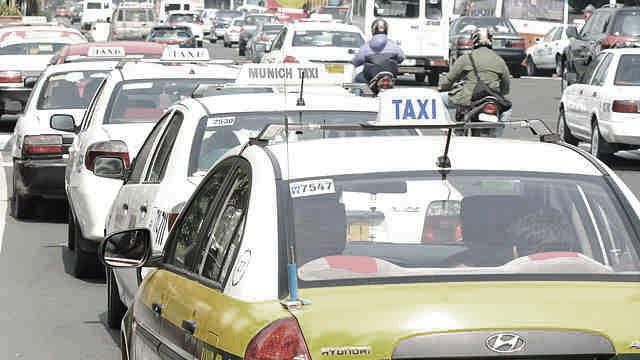SUMMARY
This is AI generated summarization, which may have errors. For context, always refer to the full article.

The Department of Transportation and Communications has given the green light to ridesharing services, like Uber and Grabtaxi, to operate as “Transportation Network Vehicle Services” – and taxi operators are up in arms!
Cab companies say the new guidelines create an unfair playing field, since ridesharing drivers are not subject to the strict rules that they themselves have to follow. The operators are threatening to go to court to protect their industry.
I agree that “Uber-like” services pose a real threat to the regular taxi industry, and I sympathize with any honest, hard-working taxi drivers who may be squeezed out by technology and innovation. But I have to wonder: Who’s really to blame?
The way a taxi system is supposed to work is quite simple. You stand on the side of the road and wait for a passing taxi. The first cab that comes along stops, you get in, state your destination, and the driver silently begins to drive. Upon reaching your destination, the driver charges you the amount on the meter, you pay, and you get out. It’s all supposed to happen in that order. Every time.
According to the law, there’s not supposed to be any negotiation about price, and the driver does not have a choice about whether or not to carry you. As a public service, and more importantly, as an integral part of the public transportation system, this is the way it’s supposed to work. In fact, this is the way it does work in many cities around the world.
In Metro Manila however, the reality is quite different.
For the average taxi passenger, difficulties start even before they board the vehicle. Despite a law that clearly prohibits the practice, taxi drivers openly choose which passengers they will stop for, driving right past others. And when a driver does stop, he expects (and often demands) passengers to state their destination and negotiate a price, even before allowing them into the vehicle.
Most of the time, the driver just cracks the window a bit, forcing passengers to negotiate ever so politely through the crack. Other times, passengers are expected to lean in through an open door, and almost beg the driver for service and a fair price.
In my observation, passengers have about a 50/50 chance of being accepted. But just as often the driver just shakes his head and drives away, leaving a helpless passenger standing in the street… sometimes even in pouring rain.

Once inside the taxi, it’s another gamble to see if the driver turns on his meter. Some do, but most don’t. Again, the law is clear but there doesn’t seem to be any serious effort to enforce it. Asking a driver to use the meter can lead to an argument, which most Filipinos prefer to avoid. In most cases, drivers just dictate the fare.
If I want to complain, my only option is to physically go to a government office and swear out a formal complaint, and then attend one or more hearings. This is simply not realistic, does little to motivate compliance, and does nothing to solve my immediate problem of getting to my destination.
And complaints to the taxi operator, made by calling the number posted inside most taxis, are even more frustrating. In most cases, drivers do not seem to be directly employed by the operators, and therefore operators have little ability to control or discipline them. Drivers are essentially just people who pay a “boundary”” to rent the cab for the day.
I have, by the way, tried to ask a nearby policeman for help once or twice. The usual response? “Sir, you should just look for another taxi.” Enforcement? Doesn’t happen.
Filipinos seem to accept all this, grudgingly, as the way it works. As a foreigner without a car, I find it maddeningly frustrating. How much I will pay, and even whether or not I will be allowed to get in the car, are entirely at the whim of a driver who is licensed by the state and required by law to provide transportation service, under a set of rules that are only minimally enforced.
All in all, to call the Metro Manila taxi system a “service” is a real stretch of the definition.
There are many hard-working, knowledgeable, courteous taxi drivers plying the streets of Metro Manila, but the problems I just described are the common experience of the average taxi passenger. As it currently operates, the Metro Manila taxi system is unprofessional, unfriendly, and quite often, uncontrolled. Drivers ignore taxi regulations, and worse, with impunity.
With this kind of “service,” it’s not surprising that the riding public eagerly embraces new transportation options like Uber. It’s not only a matter of cost, or a question of dilapidated, old vehicles. People are clearly willing to pay more for the kind of service Uber and similar companies offer.
The real issue is that ridesharing companies provide the professional transportation service that people want. Their drivers don’t pick and choose passengers, don’t argue about the fare, and don’t refuse to take passengers to their destination. This is what people want.
The ridesharing concept has arisen in response to a demand from the riding public for better service. If the playing field isn’t level, it’s not because ridesharing companies are competing unfairly. It’s because taxi service, as it works today, is lousy.
If taxi operators want to compete, they only need to do one thing — improve the quality of their service. Obey laws and regulations, treat passengers as valuable customers, and operate like a true public service.
A little bit of technology, like booking apps, wouldn’t hurt either. Taxis outnumber ridesharing vehicles 10 to 1. It’s still easier to catch a cab than to wait for an online rideshare. There is still a place for regular taxis but not if they don’t change quickly. – Rappler.com
Michael Brown is a retired member of the US Air Force, and has lived over 16 years in the Philippines. He writes on English, traffic management, and law enforcement issues.
Add a comment
How does this make you feel?
There are no comments yet. Add your comment to start the conversation.